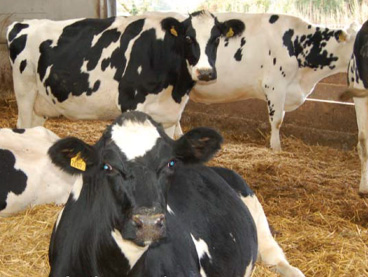Using Omega 3 Supplement has helped one of the UK’s foremost Limousin herds achieved improved success with ET.
Omega 3 supplement increases ET conception rates
Using Omega 3 Supplement has helped one of the UK’s foremost Limousin herds achieved improved success with ET.
The Glenrock herd of Limousins from Howgillside near Lockerbie is run by Stephen Illingworth, his wife Helen and their son Thomas. They moved to the farm from Yorkshire in 1995.
The aim of the herd had been to breed top quality bulls for both the pedigree and commercial markets. Their policy was to source the best possible bulls, complimented with judicious use of AI. This strategy allows the herd to make the best use of available genetics.
In 2014 they were given the opportunity to buy the farm and took the decision to sell the vast majority of the herd, which totalled 45 cows mainly going back to three dominant female families to fund the purchase. They retained the matriarch of the herd, Glenrock Spangle who has produced progeny worth over £500,000 in her lifetime, including the world record Glenrock Illusion who sold for £125,000.
They then set about rebuilding the herd using an extensive embryo transfer programme. Stephen has used ET for many years, producing around six ET calves per year so was experienced with the techniques. They purchased 50 Simmental x Luing heifers from high health status herds across Scotland to use as recipients for embryos, principally collected from Glenrock Spangle.
“We were comfortable with using ET and were confident we could establish another outstanding herd based on some of our initial genetics and by using leading AI sires,” Stephen comments.
Conception rates are the key to cost- effective ET programmes and after discussions with David Bonsall from UFAC and Simon Mellor from McCaskies Farm Supplies, the Illingworths agreed to trial UFAC Omega 3 Supplement.
Omega 3 fatty acids (EPA and DHA) play a key role in reproductive functions. They help ensure strong follicles which result in larger, more viable eggs and stronger cycling behaviour. Secondly, they help reduce early embryo mortality by stimulating higher levels of progesterone and lower concentrations of prostaglandin at the time of conception.
For the study, two pens of heifers were fed 100g/animal per day of Omega 3 Supplement for six weeks prior to implantation and six weeks after, until pregnancy diagnosed. A third group acted as a control and was not supplemented. All other management and ET procedures were the same across all groups.
In the trial 32 heifers were synchronised and 27 embryos implanted. The conception rate in the treated groups was 55%, while for the control animals it was 50%, giving a 10% increase in conception rate in treated animals.
Stephen says: “We know from our experience that the results with ET can vary considerably as so many elements have to fall into place. “We were rather disappointed with the initial results which we think, in part, were due to implanting a higher proportion of IVF embryos which tend to have a lower conception rate. However, we were impressed that the supplemented heifers had a 10% higher conception rate”.
Heifers not in calf initially were then re-synchronised. The result were significantly better with an 84% conception rate in treated animals and 74% in the control.
“The results for the second batch were far better, possibly as fewer IVF embryos were used. Yet again the Omega 3 Supplement helped deliver a 14% increase in conception rate. “At a cost of £7.14 per cow for the supplementation, it would be an easy decision to use Omega 3 Supplement in future,” Stephen continues. “In simple terms every extra Spangle calf is a huge bonus and we got a 10% improvement which is particularly welcome as Spangle is now 18 years old and deserves to go into retirement.”
David Bonsall comments: “The study clearly shows the impact Omega 3 Supplement has on reproductive performance, making it a valuable addition to the diets for dairy cows, dairy heifers and commercial beef cattle as well as leading pedigree herds.”


 Back to News
Back to News 



